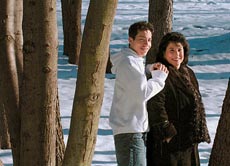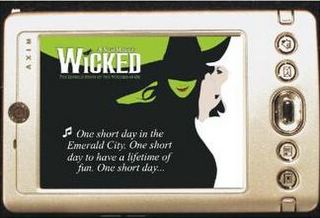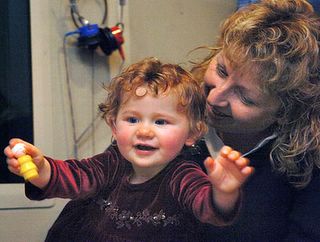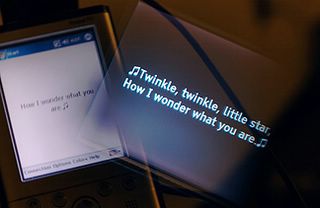
Martha Rial, Post-Gazette
Nino Russo with his mother, Bonnie Russo, in the backyard of their home in Peters. Nino was one of the first young children to receive a cochlear implant in Allegheny County.
http://www.post-gazette.com/pg/05039/454112.stmCochlear implants take children out of the silent worldDevices bring hearing and speech to deaf children, but their use remains controversialTuesday, February 08, 2005 By Virginia Linn, Pittsburgh Post-Gazette
--------------------------------------------------------------------------------
Six years ago, Bonnie Russo was in Erie to attend a soccer tournament for her son, Marco. Along for the ride was her younger son Nino, who was 11. He has a cochlear implant, a device that helps profoundly deaf people hear. The family stopped at a fast-food restaurant and encountered students from a New York school for the deaf. They took one look at Nino's implant and started signing feverishly with the help of their interpreter. They assailed Russo for choosing the implant for her son. But Russo was having difficulty conversing with them because of the signing. "They were telling me how wrong I was,'' she said. "And there was Nino, ordering at the counter what he wanted, all by himself. "When the
interpreter got up to go to the rest room, we were lost. I couldn't sign; they couldn't speak.'' That encounter erased any doubt that Bonnie and Jerry Russo may have had about pursuing an implant for Nino, who was born deaf. The devices, which are surgically implanted into the skull to stimulate the natural mechanism by which the brain receives and recognizes sound, were approved by the Food and Drug Administration for young children in 1990. So when Nino was 3 1/2 in 1991, he became one of the first young children in the region to receive the implant, in his right ear. The decision put the boy and his family into uncharted territory. Nobody really knew how effective this device would be in helping deaf children develop language. How could it be most effective? Would it help children fit better into a hearing world? Now at 17, Nino says he's doing just fine. He's a junior at Peters Township High School. He plays on three soccer teams, has friends and makes good grades. He recently got his driver's license and chats on a cell phone like any other teen. And he's been named twice by teachers as Student of the Month, a rare honor in the district. The world's only liberal arts college for the deaf is Gallaudet University in Washington, D.C. But Nino is exploring plans to attend what the deaf community calls a "hearing college" -- University of Miami, more than 1,000 miles away in Florida. Nino's progress and that of other teens who received implants when they were very young are being watched closely by educators, researchers and parents. "He would have been a deaf-mute had he not gotten a cochlear implant," said Dr. Douglas Chen, an ear specialist at Allegheny General Hospital who implanted Nino's device. "He represents what the potential of cochlear implantation is in children. ... It is literally a life-changing device.'' Bonnie Russo, a physician's assistant, agreed. "He completely interacts with the oral world and does not sign. I left that option up to him. At this point he has no desire to learn. He doesn't find a deficit anywhere in the ways of communicating." Strangers who meet him and learn that he's deaf "walk away in awe,'' she said.
Screening for babiesWith Pennsylvania now mandating newborn hearing screenings and the FDA lowering to 12 months the age at which babies can receive cochlear implants, interventions are coming earlier for the one in 1,000 babies born profoundly or completely deaf. The earlier the assistance, experts say, the more likely that deaf children will speak and comprehend language normally later. The period from birth to 3 1/2 is the "golden period" of plasticity, in which the brain is able to absorb language at an astounding rate that will never be matched in a person's lifetime. But how best to educate deaf children is an old debate that shows no signs of ending.
It's the oralists, those who believe that deaf children should focus on speaking, vs. those who support Total Communication, which includes auditory training and the use of the hand symbols in American Sign Language. Nationally, 50 percent of deaf people sign and 50 percent enter oral programs. Here in Western Pennsylvania, most children diagnosed with hearing loss enter a Total Communication program, primarily because of the strong deaf community anchored around the 136-year-old Western Pennsylvania School for the Deaf in Edgewood. Until being mainstreamed in seventh grade, Nino Russo attended the all-oral magnet school DePaul Institute. The 97-year-old school in Shadyside recently changed its name to the DePaul School for Hearing and Speech and is stepping up a marketing campaign to promote what it calls the remarkable success of its students in developing language and literacy skills in step with their normally hearing peers. The school has 70 students -- most with cochlear implants -- and will start a special program there in April for children 18 months to 3 years.
"The implants have changed the whole landscape of deaf education," said Apryl Eshelman, DePaul's director of institutional advancement. Years ago, students weren't mainstreamed until high school; now, with implants, digital hearing aids and newborn hearing tests, children are heading to regular schools by kindergarten or first grade -- many with no trace of deaf speech. DePaul's curriculum immerses children in listening, lip reading, language and speech training. Sign language is not taught, which Eshelman says would prevent them from getting the full use of the implant to develop strong oral-auditory skills. That's because it's easier to sign than to go through the intensive oral program, Chen said. Given the choice, a child will take the path of least resistance. "If you put a cochlear implant in a child, probably an oral school is best suited to that child's educational needs," he said. "Not everybody is going to be a Nino Russo. Some kids will do better even with a cochlear implant by signing. There is a place for a Total Communication school, but you'd like to at least give the cochlear implant its maximum opportunity right up front."
Researchers of a National Institutes of Health study who have followed 180 children who received implants in the 1990s are coming to that same conclusion. At a gathering last summer in St. Louis of 30 of those children, including Nino, researcher Ann Geers observed dramatic differences in speech quality and academic performance between those who had been educated in all-oral programs vs. Total Communication. "On average, these kids in oral settings are doing significantly better,'' said Geers, a professor at the University of Texas Southwestern Medical School who has worked with deaf children since the 1960s. Her biggest surprise was the reading level that these children had achieved. "I did not expect for half of the kids to be reading at grade level, that's atypical of profoundly deaf kids. The highest level kids are seen at are eighth-grade level. We have half of these kids at 10th and 11th." Part of the reason for this is that most deaf children are born to hearing parents, whom statistics show, rarely become proficient in sign language. "If you are a normal hearing parent functioning in a normal society, what you want for your child is to participate in that world, to join that world and to join that culture, and I think these kids, in fact have,'' Geers said about many of the teens she met last summer.
Does deafness need fixing?Those in the deaf community who oppose cochlear implants for children under the notion that it's an attempt to "fix" deafness, say children should not have to make a choice between the hearing or nonhearing world. Implants are not a cure; children are still deaf, and because of that they are part of a population that has its own culture,
language and heritage.
"What's wrong with being deaf?'' asked M.J. Bienvenu, chair of American Sign Language and Deaf Studies at Gallaudet University who was born deaf to deaf parents. "We've got a culture. We're
bilingual. We're not half a person. We're actually double." Although she acknowledged that many hearing parents have trouble learning sign language, she said it's a myth that they will "lose" their children if they become involved in deaf culture. "Being a deaf person, I've experienced deaf culture and American culture. I don't feel a sense of loss from my end. I don't feel I'm missing anything. I'm a Ph.D. I travel. I have many wonderful friends. I have a full life. I do everything every average American does.''
According to the National Association of the Deaf statement on implants, language and communication should not be equated with speech: The absence of visual-language training, such as sign language, might result in developmental delays that become difficult to reverse. Natalie Long, president of the American Society for Deaf Children, a nonprofit parent organization that is holding its 19th biennial convention in Pittsburgh this summer, said some deaf adolescents who have tried to be a part of the hearing world experience identity issues. She's known of deaf children who have stopped using their implants when they've become teens and learned to sign. "They want an identity. It's one of the things we all need in this world -- the sense of belonging in this group.''
Don Rhoten, superintendent of the Western Pennsylvania School for the Deaf, said the explosion of technology is putting deaf people who sign on an even playing field with the rest of society. For example, the school recently acquired 20 video relay systems that allow the deaf to use the telephone with the help of a certified American Sign Language interpreter and high-speed Internet connection. (Bienvenu used the system to speak to this reporter.) Twenty-eight of the school's 200 students have implants. Thirty percent of the total enrollment has additional handicaps, but the other 70 percent are "average people of various levels of skills and abilities," he said. "We have 200 kids and 200 different programs." Kylea Stewart, 14, of Bradford, Pa., who received her implant at age 10, joined WPSD this fall after being at a mainstream school. She wanted to learn more about the deaf culture. She said she found it difficult to meet the expectations of her hearing peers "perfect clothes, good taste in music . . ." Another student, Danah Richter, 16, of Arnold, was 2 and the youngest child to receive an implant in Pennsylvania in December 1990. Chen at Allegheny General also implanted her device. She has always attended WPSD and relies heavily on signing. When younger, she would throw off the ear piece because it was uncomfortable. Even at WPSD, other students called her a "robot. The kids would always pick on me.'' While she still wears the implant, she sometimes misses the annual adjustment, known as "remapping" that ensures the optimal performance of the device. Her older model must be remapped at Allegheny General (newer ones are done at WPSD) a difficult trip for her family. Both Long and Bienvenu believe the benefits of implants are oversold. They're concerned that parents don't hear the full story and don't understand how much work is involved in training students to use them. "We're getting the false myth that, 'Hey, you get a cochlear implant and boom! You're normal,''' said Bienvenu, adding that only a small percentage come close to this vision.
It's not perfect hearingAlthough Nino would probably fall into that top percent, he follows an Individual Education Plan for special education students in the Peters Township School District that allows him preferential seating in a classroom -- usually in the front row -- for optimal learning. With just a hint of deaf speech (because he got the implant at 3), he continues with weekly speech therapy. He has difficulty making out conversation in large groups, where everyone is talking at once. The day of focused concentration at school leaves him wiped out. He uses
closed captioning for some TV shows (but definitely not for sports or Steelers games, he says).
For soccer, Nino wears a sweat band over his implant to keep it dry; moisture can knock it out. He had a bit of a scare last summer when he attended a soccer Olympic development program in New Jersey. It was a hot, humid day and he had started to perspire before he put on his sweat band. The implant stopped working. He tried to text-message his mother in Pittsburgh, but she didn't know how to message back. Finally a roommate helped him make a phone call. Nino ended up putting the implant in front of a fan overnight to dry, and by morning it was working. "Over all these years, that was the first glitch," Bonnie Russo said. He's never without hearing aid batteries -- lots of them. They last between two and three days, so he carries them in his pants' pockets, book bag, everywhere. Nino can swim if he takes off the outside attachment, but then he can't hear. He has to be careful when his friends are engaged in water balloon fights or are pushing people into the pool for fun. "I hate to worry about it, but I hate to take it off because I want to hear,'' Nino said. But his push to excel also has helped him develop the confidence to stand up for himself. This impressed his physical education teacher, Lois Murray, who nominated him in the fall for student of the month. She had asked her class to run a mile. "The other kids were saying 'Don't run, Don't run.' He went ahead and ran. He didn't bow to the peer pressure. "At this level, I see students who don't give 100 percent. I think Nino gives 110 percent. He's a role model.''
Still room for second-guessingAlthough cochlear implants are more common, the decisions for parents to pursue the operations for their children haven't gotten any easier. Fourteen-month-old Shayla McCoy of New Sewickley Township received an implant on Nov. 11 at Children's Hospital of Pittsburgh, which expects to perform its 100th implant this spring. "We've been second-guessing this from the last moment," said her mother, Sharmane, at the time of the operation. "Are we making the right decision? Will she be upset?" Shayla has moderate to severe hearing loss. Both her paternal grandmother and grandfather are hard of hearing, and two aunts are deaf, so there is much signing in her family. She was back at Children's on Dec. 13 when audiologists turned on the implant for the first time. As the volume has been increased over time, the change has been dramatic, McCoy said. "It was like she was sleeping, and she's waking up.'' The implant is just the start of many decisions for the family as Shayla grows up. "Should she be in a nonhearing world or a hearing world?'' asked McCoy. "That's a big decision.''








